Home prices in the predominantly Black and Latino neighborhood began to tick up before then-Mayor Bill de Blasio announced plans to rezone 190 blocks in 2014. But affordable housing advocates and local residents say the rezoning, approved in 2016, only drove more speculators to scoop up homes, jack up prices and push out existing residents.
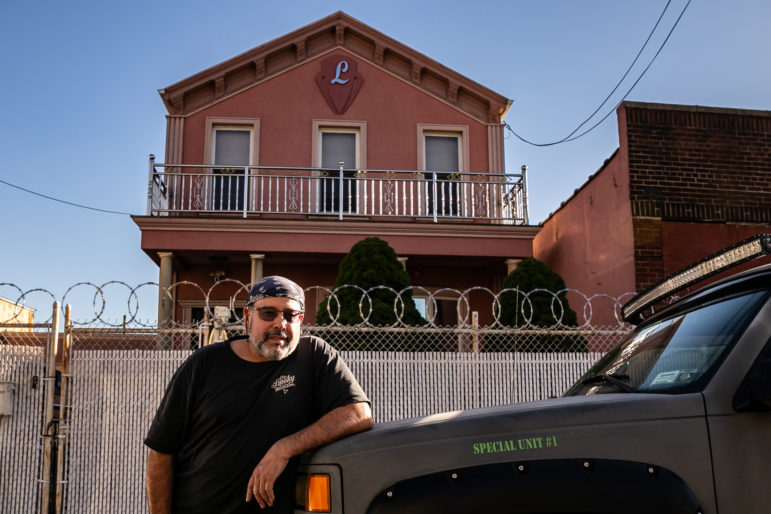
Adi Talwar
Nelson Llorens in front of his East New York home on Glenmore Avenue. Developers have regularly approached him and offered to buy his property, he says, though he is holding out for the highest offer he can get.The two-family home on East New York’s Bradford Street has changed hands four times in the past three years, tripling in value along the way.
Joyce Davis bought the place for $133,000 back in 1998, property records show. Two decades later, in October 2018, Davis’ estate sold the home for $195,000 in cash to a limited liability corporation. Under the terms of the contract, the buyer, Sasson Developer LLC, agreed not to resell the property for more than $234,000 until 90 days had passed.
Just three days after that waiting period ended, Sasson flipped the home to another entity, a firm called Dee Cee Property Mgmt & Consultants LLC, for $435,000, records show. In August, the property turned over once again. This time, a real estate agent and mortgage broker bought the home from Dee Cee for $670,000—nearly a half million more than the 2018 sale price.
It’s an example of the kind of house flipping rampant in East New York, a transit-rich neighborhood with thousands of two- to four-family homes upzoned by the city in 2016. Home prices in the predominantly Black and Latino neighborhood began to tick up before then-Mayor Bill de Blasio announced his plans to rezone 190 blocks of East New York in 2014, analyses showed. But affordable housing advocates and local residents say de Blasio’s plan, approved by the City Council in 2016, only drove more speculators to scoop up homes, jack up prices and push out existing residents.
“It’s not families purchasing homes. It is investors that are purchasing homes; LLCs that are purchasing homes. And that’s destabilizing our community,” said East New York Homeowners’ Association Chairperson Albert Scott at an October forum. “It’s increasing prices for the next family that wants to purchase a home [and] if you have a high mortgage, it’s going to increase the rents.” (The stakeholders involved in the Bradford Street sales did not return calls seeking comment).
Scott discussed the local real estate speculation at a forum to educate residents about a bill intended to curb the practice. The legislation, introduced by Queens Assemblymember Catalina Cruz and State Sen. Julia Salazar, who represents East New York, would impose heavy taxes on property owners who sell one- to three-family homes within two years of buying them, with some exceptions.
The measure specifically targets flippers by pegging the tax to the difference between the purchase and sale price: 65 percent for homes flipped in less than a year and 50 percent for homes resold between one and two years after purchase. In the case of the Bradford Street home, the $240,000 price difference between the 2018 sale and 2019 resale would incur a $156,000 tax under the proposed measure.
Salazar said the measure is necessary to preserve affordable housing in the gentrifying neighborhood. “The practice of house flipping is not harmless,” she said at the forum. “House flipping exacerbates wealth inequality in our city.”
Affordable housing squeeze
On a recent walking tour of East New York and Cypress Hills, housing organizer Alexa Sloan and Brooklyn Community Board 5 member Jessica Franco pointed out several flipped homes, many of them coated with a familiar shade of paint.
“That’s gentrification gray,” said Sloan, of the Cypress Hills Local Development Corporation (CHLDC), as she gestured to a three-story attached home just north of Atlantic Avenue.
The paint color has become a kind of marker in gentrifying neighborhoods throughout New York City and elsewhere in the country, where investors have sought to attract wealthier residents, many of them white, into working class communities of color.
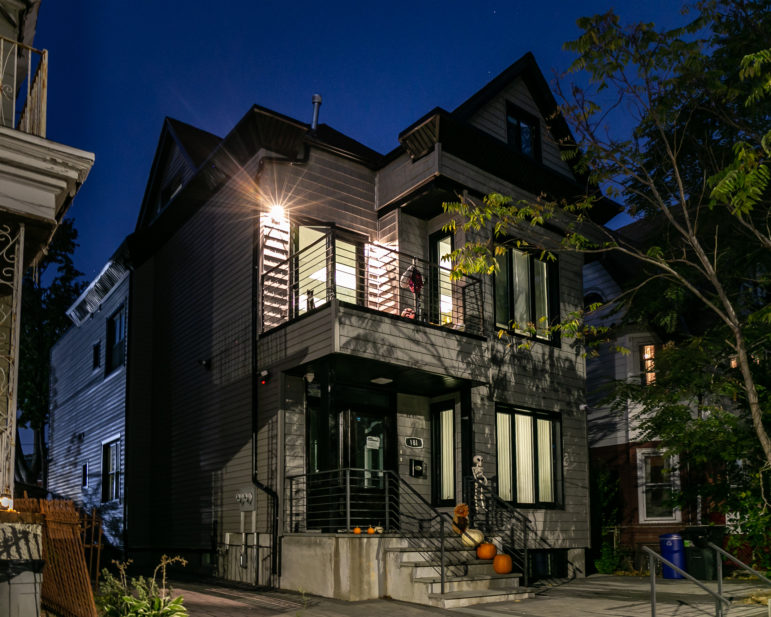
Adi Talwar
This home on Arlington Avenue sold for $420,000 in 2018, then again for $1.23 million in June of 2021, property records show.The flipped homes can further reduce the affordable housing stock in a neighborhood because tenants in buildings with fewer than six units are not protected by all of New York’s rent laws, Salazar said. A new owner can simply deny them a lease renewal and order them out.
That’s a particular problem in East New York, where low-income renters make up the largest share of the population and working class homeowners struggle to keep up with rising property taxes, said Franco, the Community Board 5 member. More than half of tenants in the neighborhood are rent-burdened, meaning at least 30 percent of their income goes to housing, according to the city’s most recent community health profile. That number, along with unemployment, has likely surged since the pandemic began.
When Franco purchased a home in East New York, she said she and her husband decided to deliberately rent their units to working class people of color.
“Small homeowners are the ones providing the real affordable housing,” she said. “Rental income is part of ownership, but there’s no need for greed.”
That’s not necessarily the perspective of the investors who routinely knock on homeowners’ doors and make unsolicited cash offers, or who blanket the neighborhood with flyers offering cash for homes.
A 2018 report by the Center for New York City Neighborhoods (CNYCN) found that investors were flipping more homes in Brooklyn’s Community District 5, which includes East New York and Starrett City, than in any other district in the borough in 2017. Only Southeast Queens’ Community Districts 12 and 13 and The Bronx’s Community District 12 (Williamsbridge and Baychester) had more flips than East New York’s 126 that year.
Flippers target distressed properties, with lower-income owners facing possible foreclosure, often because they cannot afford to keep up with their mortgage or property taxes. That arrangement enables investors to pay a pittance, usually in cash, compared to the actual market value of the home. East New York’s median sale price for non-flip one- to four-family homes was $261 per square foot in 2017, the CNYCN analysis found. For homes that buyers intended to flip, it was $186 per square foot.
East New York has more of those properties than most neighborhoods. The overlapping council district has more houses on the city’s tax lien sale list, made up of homeowners who’ve racked up municipal debts, than any other.
Median sale prices in Community District 5 have surged over the past 10 years, rising from $189,880 per unit in a two- to four-family building in 2010 to $354,500 in 2020, according to an analysis by New York University’s Furman Center, which uses the 2020 dollar-equivalent for older transactions. The 2010 price was impacted by the Great Recession, which plunged thousands of homeowners into foreclosure, but the 2020 median price still outpaces the 2006 amount by about $50,000.
Real median gross rents in CD5 have also risen since 2006, from about $1,110 to about $1,220 in 2019, the Furman Center found. Meanwhile, the real estate website Zumper determined that the average rent for a one-bedroom apartment in East New York rose from $1,250 in April 2015 to $2,043 in February 2020, before dropping to between $1,500 and $1,700 for most of the pandemic.
In response to advocacy by East New York residents, the state designated parts of the neighborhood as a “cease and desist zone” to curb the nonstop speculation. Homeowners who live in the cease and desist zone can register with the Department of State to ban real estate investors from making unwanted and repeated solicitations to buy. The investors face initial fines of $1,000 if they call, visit or send mailers to homeowners who opted in to the registry. They may also lose their licenses for repeat offenses.
Still, said community leader Brother Paul Muhammad, “speculators come by every day, every hour.”
“They see a lot of poor people on valuable land,” he added.
Cruz, the assemblymember sponsoring the bill intended to curb such speculation, said few people seem to consider the impact of the practice, which inflates local property taxes and drives up rents.
“The reason that no one was paying attention is because it’s glamorized on TV to flip homes,” Cruz said. “Everyone sees it as a way to create additional income for yourself but no one is thinking about what it is doing to that entire block, to that community, to that neighborhood, to the people who were living there.”
Results of the rezoning
Muhammad, a member of Brooklyn’s CB5 and the Coalition for Community Advancement Steering Committee, blames the rezoning for fueling a feeding frenzy on the neighborhood’s small properties, most of which are owned by Black and Latino New Yorkers.
“We were against this from the beginning,” he said.
Indeed, residents warned of the speculation to come almost as soon as de Blasio publicized his plan to change local land use rules to allow for taller buildings and greater density in East New York. It was the first in a series of neighborhoods that the de Blasio Administration targeted for rezonings, and the first to feature de Blasio’s signature Mandatory Inclusionary Housing (MIH) policy.
The results of the 2016 rezoning are most evident along Atlantic Avenue, where large housing complexes, some as tall as 14 stories, have begun to rise. The former site of Ms. Maxwell’s Bakery is now a block-long crater, where construction crews are set to erect a massive mixed-use building.
City officials estimate that the rezoning will create nearly 6,500 new apartments by 2030. In seeking the rezoning, the de Blasio administration said half of those units would be priced below market rate, including about a quarter through the city’s MIH policy, whichorces developers who build in rezoned neighborhoods to set aside a certain number of their units for renters earning a percentage of the Area Median Income.
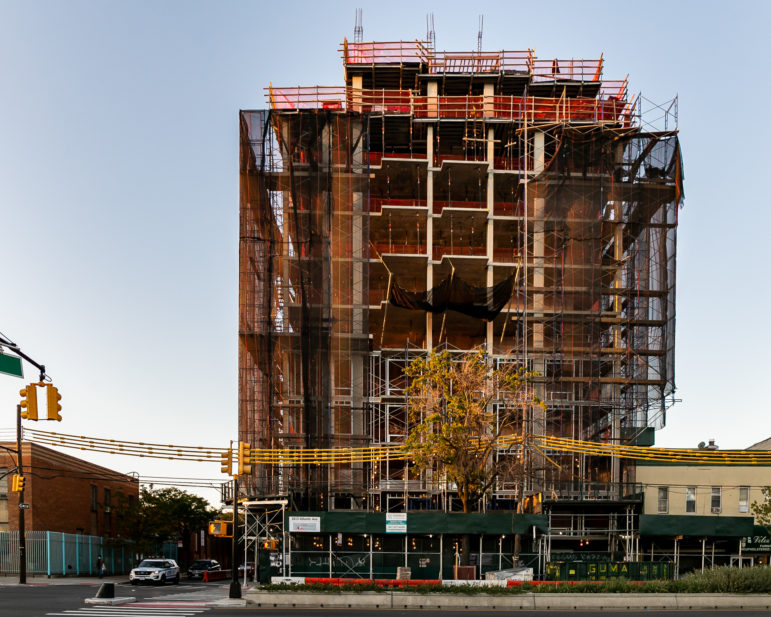
New construction underway at 2815 Atlantic Ave., Brooklyn. 
This two-family home on East New York’s Bradford Street has changed hands four times in the past three years, tripling in value along the way. 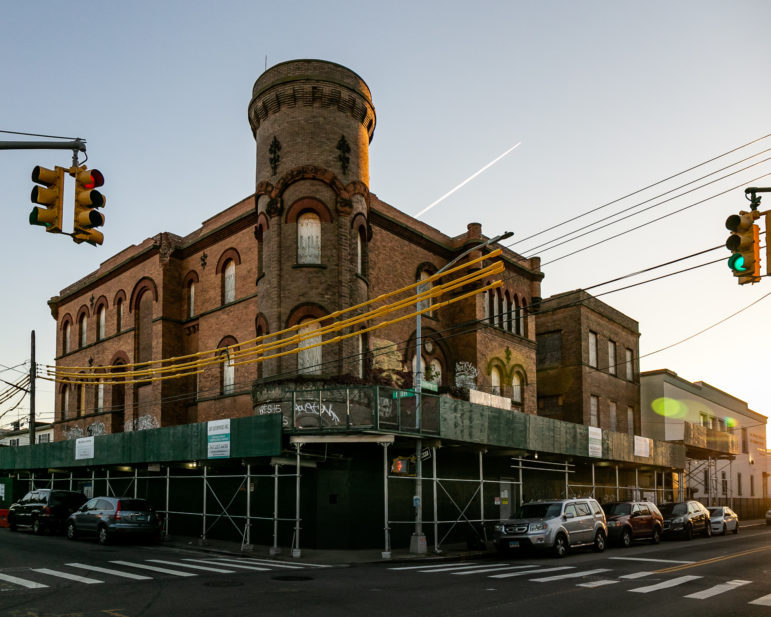
Former 75th Police Precinct Station House, a historic building at the corner of Miller and Liberty avenues in East New York. The property sold for $1.4 million in 2016, records show. 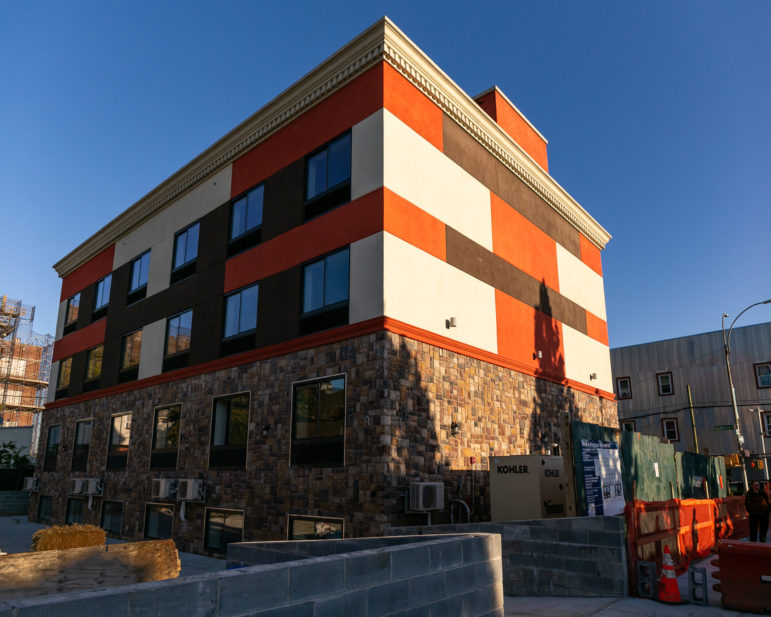
A new Hotel under construction at the corner of Glenmore Avenue and Sheffield Avenue in East New York, Brooklyn.
De Blasio pledged that developers would break ground on more than 1,200 affordable units by 2018.
Five years on, about 1,200 affordable units are indeed in the works, the Department of Housing Preservation and Development (HPD) said. But only about 100 have actually opened to tenants, Gothamist reported earlier this month.
A 2021 analysis by the CHLDC found that developers have filed permits for about 3,860 residential units in and around the rezoned area, with 1,559 affordable homes in development. Yet, local housing organizers point out, few of the units are priced for the lowest-income residents of the district. A quarter of CD5 residents earn less than $20,000 per year and median household income is $44,234, according to American Community Survey statistics.
Just under 200 of the affordable units are priced for “extremely low income” and 357 for “very low income” households, CHLDC determined. An HPD spokesperson said the agency could not confirm that data.
An analysis provided by the Department of City Planning (DCP) backed up some of CHLDC’s findings, showing that 3,863 homes have been built or financed in Community District 5 since the rezoning. But DCP contrasted CHLDC’s affordability data and said that 764 of the units are reserved for “very low income” New Yorkers—households earning 31 to 50 percent of AMI (no more than $53,700 for a family of three). Another 949 are set aside for households earning less than 30 percent of AMI (no more than $32,220 for a family of three).
Nevertheless, existing East New York residents must compete with their neighbors, as well as other New Yorkers, for the affordable units through the city’s housing lottery, facing extremely steep odds.
Housing isn’t the only area where the city has not yet upheld pledges related to the 2016 rezoning. As City Limits reported in November, the city hasn’t made good on employment goals for the neighboring Industrial Business Zone.
But city officials do point to a number of fulfilled promises, including various affordable housing developments in the works, with one already open and some on track to open in 2022, according to a recently updated account of progress on rezoning commitments. Some 659 of the units that have opened or are under development in the rezoned area will be reserved for households earning no more than 50 percent of Area Median Income ($53,700 for a family of three).
The Linwood Park Apartments, for example, features 100 affordable units, with the first tenants having moved in last year. DCP estimates that more than 200 affordable units will open above a supermarket at 50 Pennsylvania Ave. sometime in 2022. A 275-unit affordable housing complex at 110 Dinsmore Place, known as Chestnut Commons, is expected to open in the spring. And Phipps Houses is developing 400 affordable units at the former site of Chloe Foods on Atlantic Avenue between Chestnut Street and Euclid Avenue. That building is estimated to open in 2023.
The de Blasio Administration also revamped City Line Park and is in the process of renovating Callahan-Kelly Park near Broadway Junction. A new 1,000-seat elementary and middle school opened on Dinsmore Place in September.
“Thanks to our neighborhood plan and its MIH component, there is now a requirement for permanently affordable housing in East New York, which didn’t exist prior to the rezoning,” said a DCP spokesperson. “And it’s already paying off.”
In addition, city officials say they have launched a campaign to educate homeowners about the cease and desist zone, and reached nearly 1,900 East New York renters through HPD’s Tenant Support Unit, which offers resources to residents dealing with landlord harassment or potential displacement. HPD says it does not track flips, however.
And for some homeowners, the real estate speculation is a welcome, if not somewhat annoying, development. It may mean a big cash payday.
Glenmore Avenue homeowner Nelson Llorens said developers have regularly approached him and offered to buy his property for at least the last five years.
“Once the rezoning happened, everything started going crazy,” Llorens said. “It was craziness and I’ve still got investors looking to purchase it.”
Llorens lives in a pink house surrounded by warehouses and manufacturing spaces about five blocks from the edge of the rezoned area. He and his family haved lived in East New York for decades and he said he is holding out to ensure he gets what the property is really worth.
“I’ve been looking forward to the gentrification,” Llorens said. “It’s going to drive up home values.”










6 thoughts on “House Flippers Continue to Target East New York. Residents Blame the 2016 Rezoning”
When I applied for affordable housing they make u life miserable they ask u for so many papers that they don’t give u time to submit the documents then when u submitted right away they say they don’t have more unit.is been happen to me 2 times already.this is a monopoly especially is u have section 8.
Damn pa you right! That sounds like some crazy shit but they really be on some monopoly type stuff. These niggahs is crazy.
Former ex-Nyer that now works in real estate law and yes I find the house flippers greedy and obnoxious/ they destroy neighborhoods with their greed. As an ex-Brooklyn resident no one in their right mind would want to buy and live in East New York unless you are on welfare. Residents of East New York don’t sell out. The area filled with gangs, guns, and crime so far away in sense for easy commute.
The Barrons warned about this, but Rafael Espinal voted this up & now gentrification will work its way into ENY from the north side.
The Barron’s are part of this, dont be fooled they have profited. Do a deep search into their real-estate holdings, just saying. East New York needs new representation. Watch the ENYCLT closely they are the only authentic racial and environmental justice for the community, the future depends on their success! Join the movement and stay informed it is the only way to fight back, gain traction, and preserve what is left.
The Baron’s have for years fought the good fight for ENY. They have together forught in the assembly and council by way of legislation-the best and good fight! Should they acquire some property rather than greedy absent any vested interest in community real estate developers in our Black and Brown communities-
GOOD!!! Better them that have fought for us! Don’t hate!!